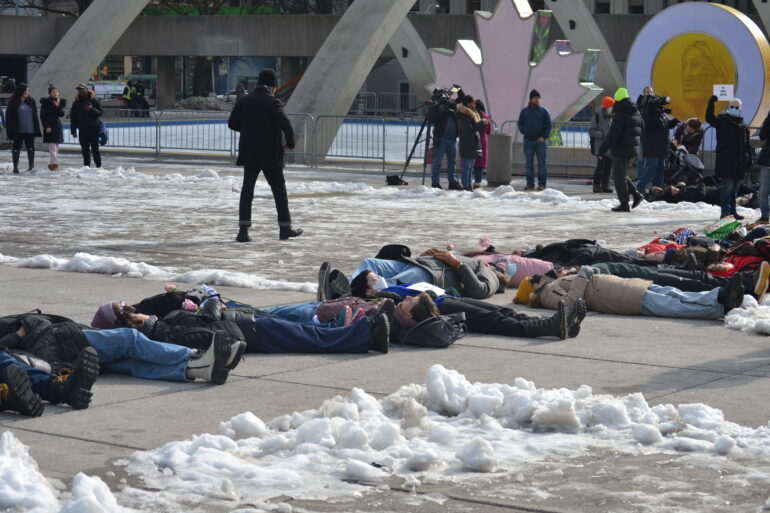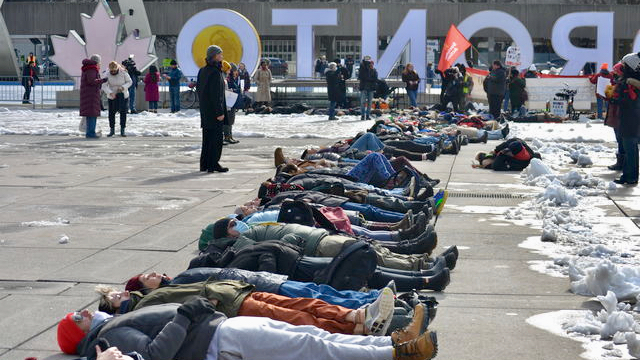Bodies lay face up across the icy pavement outside Toronto City Hall on Feb. 6, 2023.
“This is a way to honour people who have died who are unhoused,” said Lorraine Lam, outreach worker for the Shelter and Housing Justice Network.
Housing advocates staged a die-in as a form of protest to demand that the city invest more funds into protecting those who are unhoused.
The protest, organized by the Shelter and Housing Justice Network and Health Providers Against Poverty, called on the city to open warming centres 24/7, just days after temperatures in Toronto dropped to minus 29 degrees celsius on Feb. 3.
Dr. Talveer Mandur, resident physician and member of Health Providers Against Poverty, read a statement to protesters and said the lack of warm shelter space is driving unhoused people to dangerous lengths to survive.
“In desperation to stay warm and find respite, people are riding the subway, on overnight buses, sleeping at Union Station, and going to free business that are open late” he said.
“These options are unsafe, unethical and put people at risk of violence and increases policing,” Mandur said.
Toronto currently operates four warming centres across the city with a total capacity to fit 195 people.

According to the city, warming centres open when temperatures reach at least -15 C, but advocates argue that even higher temperatures can still put unhoused people at risk of illness.
“Local research from the Map Centre for Urban Health Solutions shows that 72 per cent of cold-related injuries and hypothermia-related deaths happen in periods of low to moderate cold, which is between zero and -15 C,” Mandur said.
The Ontario Human Rights Commission released a statement Feb. 3 declaring that Ontario is in a homeless crisis.
“The OHRC urges the provincial government, District Social Services Administration Boards (DSSABs) and municipalities across Ontario to uphold the rights of people experiencing homelessness and adequately fund and provide enough indoor spaces around-the-clock for anyone seeking shelter, either in warming centres or in community spaces,” the statement said.
The statement follows a recommendation by the Toronto Board of Health that City council declare a public health crisis and urged the city to open 24/7 respite sites for those seeking shelter from cold weather.
City council voted on Feb. 8 not to open warming centres 24/7. Scarborough Centre Councillor Michael Thompson tabled a motion that was supported by 14 other councillors and the mayor seeking help from the provincial and federal governments to make the shelters available.
This defeated a motion to open warming centres 24/7 tabled by several councillors, including the recently elected Davenport Councillor Alejandra Bravo.
Bravo told Humber News the city should be investing funds into protecting unhoused individuals instead of increasing the police budget.
“We know these solutions cost money, but that’s about making priorities,” she said. “We saw how quickly 80 officers were deployed to TTC at a cost of millions and millions of dollars a month, we want the real investment in things we know are actually going to keep people safe.”

However, a supplementary report by Gordon Tanner, general manager of Shelter, Support and Housing Administration (SSHA), said the city lacks the funding to operate 24/7 warming centres.
“The estimated monthly operating costs to activate a warming centre in a city building to support 50 people with no lease costs $400,000,” the report said.
The report also said that the city’s 2023 operation budget of $16.16 billion does not include funding to support these centres.
At the Feb. 7 council meeting, Tanner noted a lack of human resources as another challenge in operating 24/7 warming centres.
“Moving to a 24/7 model means you need a three-shift rotation, means you need to provide people benefits, time off, a variety of things, it’s a more resource intensive response,” he said.
While warming centres are closed, the city offers temporary homeless shelters as a safe solution. However, advocates argue that people are being turned away due to low shelter space, leaving unhoused people turning to hospitals.
“People are going to hospitals because they have nowhere else to go, leaving hospital staff scrambling to find options for safe shelter and coming up empty,” Mandur said. “They are often discharging people with nothing more than a referral to central intake, maybe a gift card to a 24-hour restaurant.”
While city officials deliberate on the best solutions, Lam continues to reiterate that the situation is “dire.”
“We are here to say that we are in a public health emergency and they need to take action right now,” she said.

